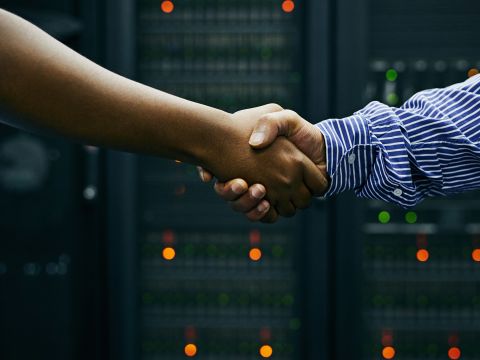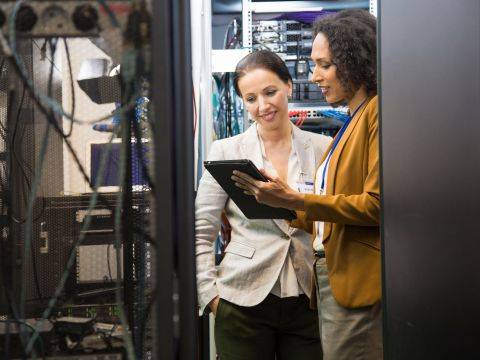Seven technologies present in Sci-Fi of the past that we can all use now
We may not have flying cars but what did past Sci-Fi get right about the future?
Predicting the future is one of the primary tenets of science fiction right from Georges Méliès fantastic vision of what a trip to the moon would look like back in 1902. Whilst we may not have flying cars in 2020 (as promised in both ‘Blade Runner’ and ‘The Jetsons’), what visions have come to pass which, when we first saw them, seemed fantastical…
Tablets
Long before Steve Jobs announced the iPad in April 2010, Stanley Kubrick realised such a device as used by the crew of the USS Discovery in the film ‘2001: A Space Odyssey’. In the scene, the two astronauts are eating dinner and both have roughly iPad sized devices that they then watch a BBC news programme on. It’s the only scene with those devices but the movie is littered with realistic viewpoints of the future. Similar devices were also used extensively in Star Trek, Personal Access Display Devices (or PADDs as they were dubbed) were used nearly as much as the ubiquitous Tricorder. Tablets have come into everyday use with more recent iPads being dubbed laptop replacements.
Smartphones
In the ’90s and early ’00s, it felt everyone had a Motorola flip phone of some kind from the Startac to the RAZR – Star Trek fans would take delight in comparing them to the communication devices from the 1960’s series. One of the coolest things I ever saw was when I was doing some work at a London Borough Council. At lunchtime, I got dragged to the pub, whilst there the guy I was working with got asked to do some changes to the telephone system. He promptly gets out his Nokia Communicator, modems into the PABX and does the change there and then and this was back in the 1990s. Modern iOS and Android phones can connect to any manner of web services, run RDP or SSH. Consider that we now have more computational power in our pocket than took man to the moon.
Video Calling
A perennial favourite of Sci-Fi are the video communications features. Video communication has been around for longer than you might think, but only really became viable in the 1980s when technology caught up. My first experience of this was with a Creative Labs WebCam and MSN Messenger (my first video conference with friends quickly degenerated into a Galaxy Quest homage). As devices got smaller and more powerful, services such as FaceTime have made the whole process even easier than before – in fact, it has been reduced to about the same as making an ordinary phone call which is also something else 2001 prophesied when Haywood Floyd makes a call from an AT&T booth on a space station.
Driverless Cars
Back in the mid-1980’s one of the coolest programs to talk about in the playground was Knight Rider. Week after week we would watch that “shadowy flight into the world of a man who does not exist” and his incredibly intelligent car. Whilst some of what the car did still seems fantastical now, some is not. For example, voice control in cars is quite commonplace now and is all about letting the driver change things whilst keeping their hands firmly on the steering wheel. Self-driving cars have been more and more in the news, with ever more investment being directed towards the technology, and whilst we might not have our own version of KITT yet, we are surely well on our way.
Digital Assistants
Another staple of Star Trek was just asking for things to happen, and Digital Assistants like Alexa and Siri now make that possible, acting as a bridge between the user (us) and any home automation devices you may have such as smart plugs, lighting, etc. They also act as a pseudo web browser; ask Alexa who won the 1987 FA Cup and you will dutifully get an answer, ask Siri to play some Jean-Michel Jarre and you start to hear the melodic tones of Oxygene.
3D Printing
We might not have the food replicators from Star Trek yet, but the ability to create complex shapes out of a roll of plastic has been around since the 1980s. A 3D printer takes a roll of plastic filament and then melts and builds shapes that could be a new tool, a replacement part or something purely decorative. Whilst arguably still the purview of the home hobbyist, larger industrial machines are now printing everything from boats to houses – one printer has made its way on to to the International Space Station.
Smart Homes
One thing the IoT (Internet of Things) has given us is a plethora of devices with which we can automate parts of the home. From your heating to your lighting to your fridge freezer. All of this can be controlled by the smartphone in your pocket. For example, my garden lights always come on 30 minutes before sunset and my heating can be turned on as I’m driving home so it is warm when I get there.
The future hasn’t delivered everything promised by science fiction of the past, but when you consider the world now, it’s not done too badly, even more so in this pandemic (Everyone has played a family Quiz on Zoom, haven’t they?!). If this had happened 5 years ago, would the move to home working been as smooth and as functional as it has been? The truth is we don’t know what the future holds – but then, who does?
More services to help
We offer a comprehensive range of IT services to suit all businesses - from "helpdesk"-style IT support to data centre hosting services.


IT Support
Your business doesn’t run itself; and neither do its IT systems. From email to Internet, your back-up server to your phone system, you need technology to run smoothly so your business can do the same.


Private Cloud
Our scalable private cloud services run on dedicated hardware. You’ll get 24/7 support, total security and lightning-fast speed; all at a fixed, all-inclusive monthly cost.


Data Centre
Our fully managed colocation services make use of data centres across the UK, to securely house your network equipment.